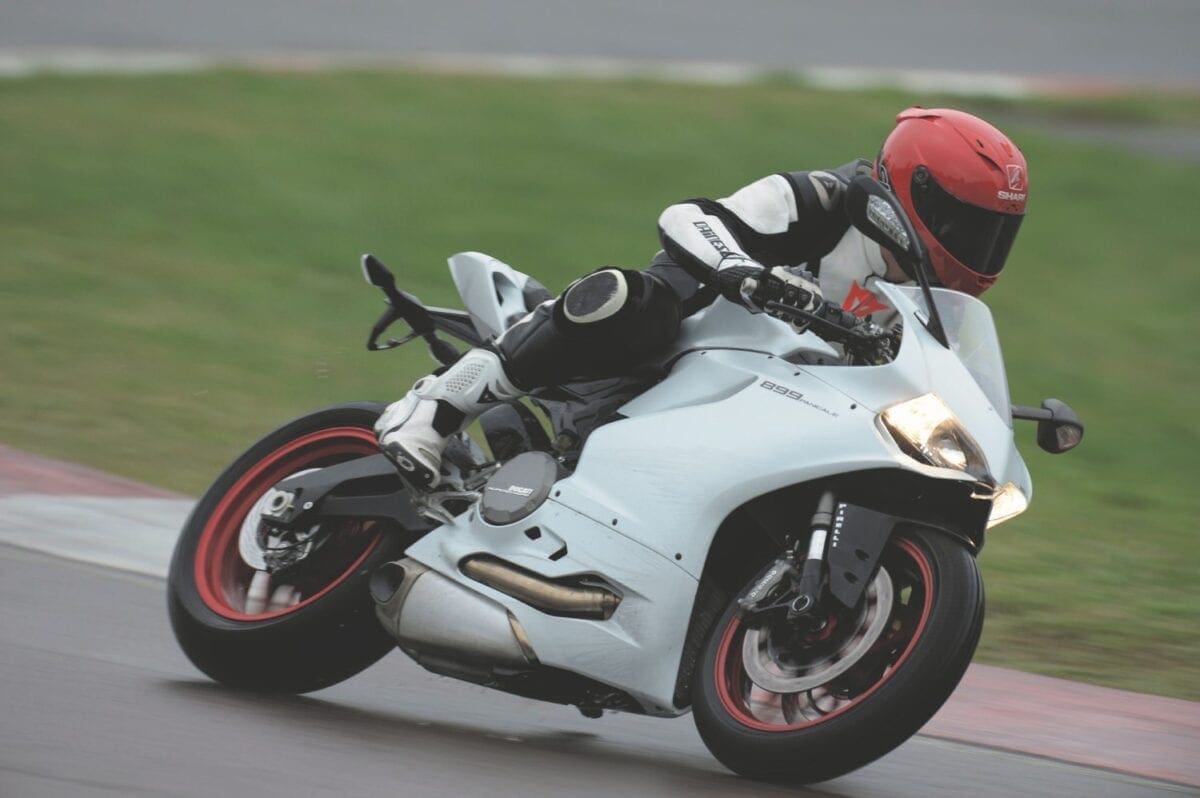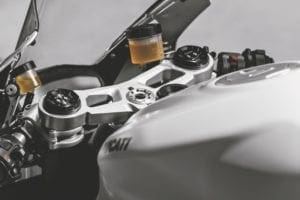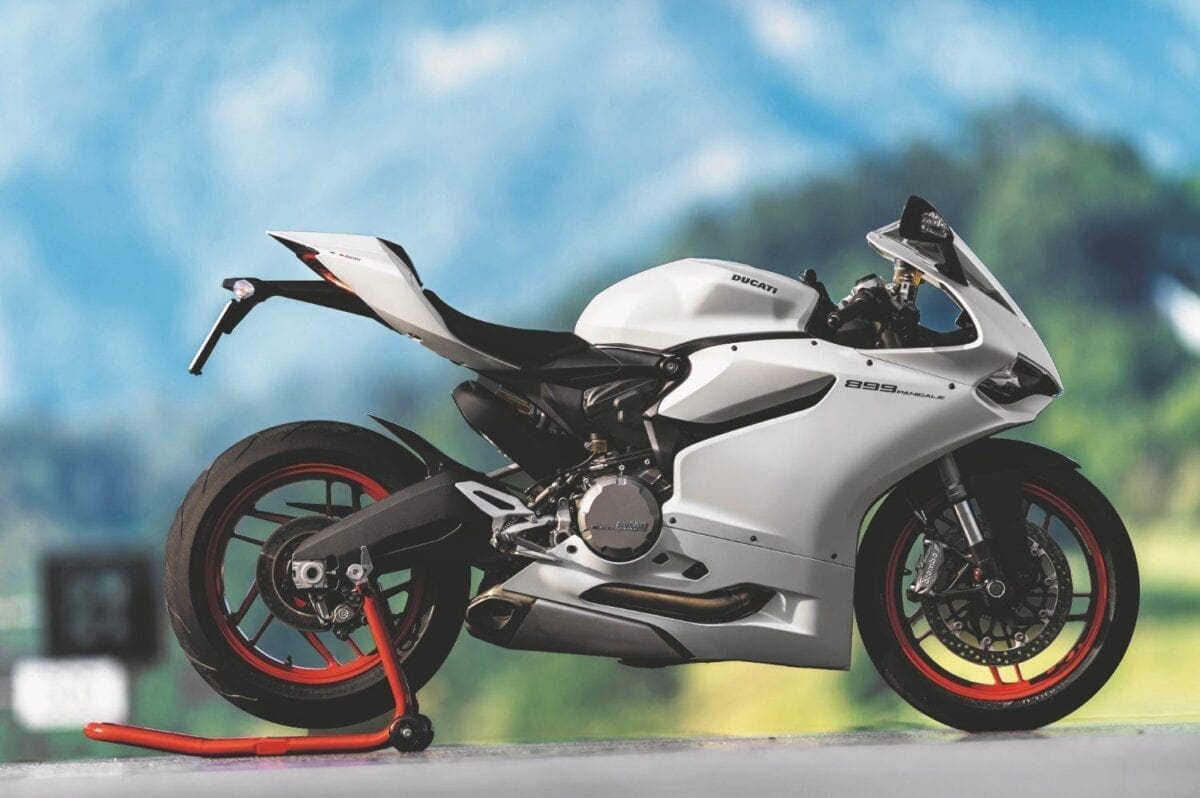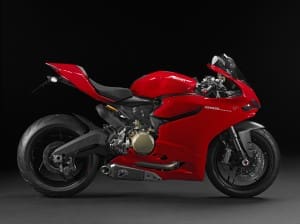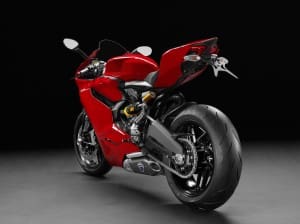£12,496 | 898cc liquid-cooled V-twin | 148bhp | 73lb-ft
The 899 Panigale looks almost identical to the 1199 that began the Panigale family two years ago, but it’s distinctly different — and not just in its engine capacity. Basically the 899 has been created to be a bit more of a practical streetbike than the fearsome 195bhp 1199. Ducati say the new “supermid”, as they call it, is aimed equally at road and track use, while the 1199 is much more biased towards the track.
 The 899 is intended to be fast but unintimidating; to give the rider more of a feeling of dominating the bike than is possible with the ferocious open-class V-twin. With its aim of rider-friendliness the new machine also differs subtly from its predecessor, the aggressively rev-happy 848 EVO.
The 899 is intended to be fast but unintimidating; to give the rider more of a feeling of dominating the bike than is possible with the ferocious open-class V-twin. With its aim of rider-friendliness the new machine also differs subtly from its predecessor, the aggressively rev-happy 848 EVO.
Of course the 899 is also intended to be more financially accessible than the big Panigale and to follow the 848 by attracting a wide range of customers including those stepping up from smaller bikes or moving to Ducati from other brands. It incorporates cost-saving features in both engine and chassis but retains the Panigale family layout, as well as a list of features including a high-tech electronics package, with quick-shifter and ABS braking as standard.
Tell me about the engine
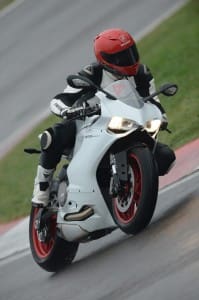 The 898cc, eight-valve desmo V-twin engine follows the Superquadro format, with dimensions of 100 x 57.2mm that mean it’s almost as radically oversquare as the 1198cc unit. Other Panigale features include the cam drive by chain and gear, rather than belt as on the 848; and the flyweight that acts as a decompressor at low revs, allowing a smaller starter motor and battery.
The 898cc, eight-valve desmo V-twin engine follows the Superquadro format, with dimensions of 100 x 57.2mm that mean it’s almost as radically oversquare as the 1198cc unit. Other Panigale features include the cam drive by chain and gear, rather than belt as on the 848; and the flyweight that acts as a decompressor at low revs, allowing a smaller starter motor and battery.
Redesigned cylinder heads include new cams and larger valves than those of the 848. The peak output of 148bhp at 10,750rpm is 8bhp higher, and the new engine makes notably more torque below 6500rpm. Its overall gearing is also slightly lower, which Ducati say helps give better acceleration from low speeds.
The new engine includes a few cost-cutting measures, such as the use of aluminium instead of magnesium for clutch, cylinder head and oil sump covers. But the 899 follows the bigger Panigale by featuring a sophisticated electronics package that includes three riding modes — Race, Sport and Wet — for rapid fine-tuning of power output, throttle response, traction control, engine braking and ABS level.
What’s the chassis like?
In similar fashion the 899’s chassis is also very much a Panigale family creation, based on a monocoque aluminium frame that acts as the airbox and uses the engine as a stressed member. The smaller V-twin unit is rotated back slightly, allowing slightly racier steering geometry. Ducati say they can get away with this because the 899 isn’t as wheelie-prone as the ferociously powerful 1199.
 Some expense is saved by using a steel instead of aluminium rear subframe, and there’s a twin- instead of single-sided aluminium swing-arm. Suspension combines Showa’s familiar 43mm Big Piston Forks — used here for the first time on a Ducati — plus a similarly multi-adjustable Sachs monoshock. Front brake calipers are Brembo Monoblocs but they’re the conventional M4 units rather than the 1199’s top-spec M50s.
Some expense is saved by using a steel instead of aluminium rear subframe, and there’s a twin- instead of single-sided aluminium swing-arm. Suspension combines Showa’s familiar 43mm Big Piston Forks — used here for the first time on a Ducati — plus a similarly multi-adjustable Sachs monoshock. Front brake calipers are Brembo Monoblocs but they’re the conventional M4 units rather than the 1199’s top-spec M50s.
Should I buy one?
If you’re captivated by the style, technology and performance of the Panigale but couldn’t justify such a hardcore or expensive bike as the 1199, then why not? At £12,495 the 899 is far from cheap — in fact it costs more than plenty of open-class superbikes — but it delivers a big dose of Panigale magic in a package that is more rider-friendly as well as substantially less expensive.
Both the ABS and the softer suspension would be welcome features on the road, where the 899 offers a few more advantages over its 848 EVO predecessor. At 17 litres its tank is a useful 1.5 litres bigger, which should increase practical range to almost 150 miles. Ergonomics are also slightly more relaxed, which should improve comfort.
Despite the wet launch weather, I left Imola even more impressed by the Ducati than I’d expected to be. Although the 899 can’t match the larger-capacity Panigale’s awesome power output and acceleration, it has more than enough of both for the street coupled with potential to be an excellent track-day bike too. The 899 is not just a less powerful and desirable version of the 1199, but a fast and capable superbike that would arguably be better suited to many riders, especially for roadgoing use.
Rain at Imola meant there was no chance to see what the 899 could really do in a straight line. But it was clear that even this so-called baby Panigale is a seriously rapid superbike, with more low-rev grunt than its 848 EVO predecessor, as well as a stronger top-end kick. That 148bhp maximum should give a top speed of around 170mph, with a smooth and sweet-revving feel.
Acceleration was also helped by the gearbox, which was impressively slick and aided by the efficient quick-shifter, unlike the notchy 848 EVO that I rode at Imola a couple of years ago. Selecting Sport mode generated as much extra wheelspin and traction control action as forward motion, even before the rain started coming down harder, eventually cutting short the test. Despite being tall I found the bike reasonably roomy, but wasn’t the only rider to find my boot occasionally slipping off a too-smooth footrest in the wet.
The chassis was also very impressive, at least as far as the conditions allowed. At 193kg wet (very wet, in this case) the 899 is 5kg heavier than the 1199 but lighter than the 848 EVO despite having ABS as standard. As well as having steeper geometry than the big Panigale it also has a narrower 180-section (instead of 200) rear tyre that should also aid manoeuvrability. Spring rates at both ends are roughly ten per cent softer, intended to give a little more roadgoing comfort, as is the thicker seat.
The Ducati certainly steered very sharply and accurately through Imola’s chicanes, and railed through the faster curves feeling very stable. Without riding it on dry Tarmac it’s impossible to know how well its suspension would have coped, although the Showa BPFs and the Sachs shock unit are well tried and multi-adjustable components. One chassis part that did have a chance to shine was the front brake, which even in the wet was superbly powerful, backed up by the grippy front Pirelli and the ABS system.
TECH SPEC:
Price: £12,495
Engine: Liquid-cooled 90-degree V-twin
Power: 148bhp (104kW) @ 10,750rpm
Torque: 73lb-ft (99Nm) @ 9000rpm
Kerb weight: 193kg
Seat height: 830mm
Tank size: 17 litres

